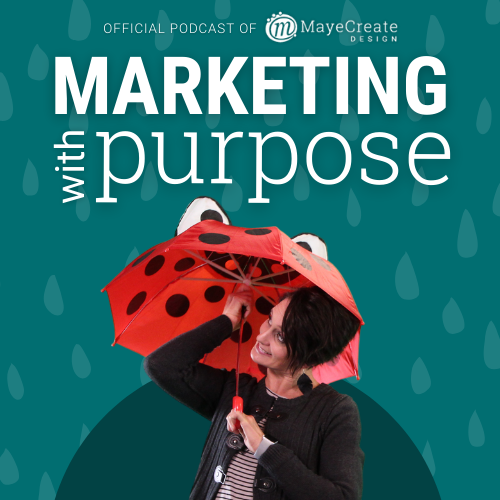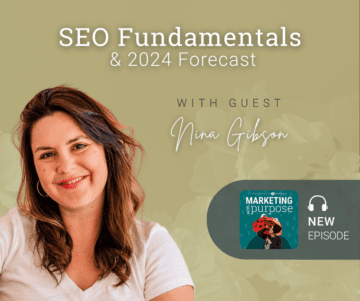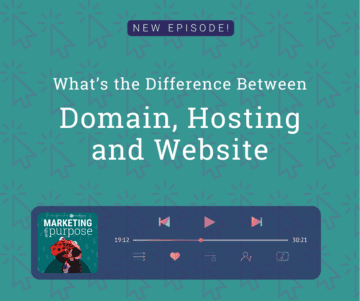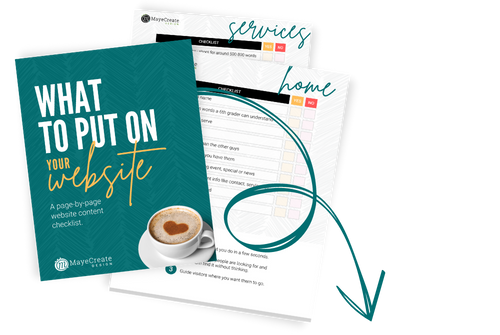Building Your Instagram Audience, with Expert Guest Julia Campbell
May 21, 2021
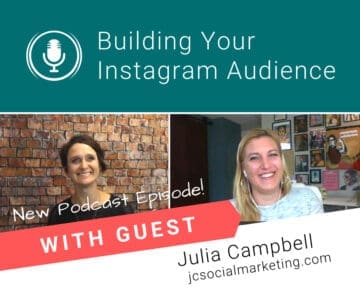
CONSUME CREATIVELY
This content is available in:
This content is available in:
AUDIO
TEXT
I’m not what you would call an Instagrammer – at least not professionally. I just post pictures of me flying around in the splits suspended from the ceiling… but I know enough to know you can’t just create an Instagram account and magically draw an audience.
I also know Instagram can be a powerful social media tool for nonprofits, but I’m no expert on how that works either. Luckily, I do know who is – and her name is Julia Cambpell. Speaker, nonprofit consultant, and author of Storytelling in the Digital Age: A Guide for Nonprofits, Julia tells us how to use Instagram the right way.
Podcast Summary Notes:
Monica: Who is Instagram good for? Is it good for everyone?
Julia: Number one, is your audience on this platform?
If you’re trying to target millennial women, or young moms or younger moms with families, or 18 to 25 year olds, then you probably need to look at Instagram.
Second, can you create content specifically for Instagram?
You can’t recycle things on Instagram, but you can repurpose. If you have a fabulous photo, you put it on your blog, you put it on your website, you put it on Facebook, you put it on Instagram… but you have to write the caption differently, you have to use different hashtags; you have to know the culture and the etiquette and the language of each–because all of these channels are so different. It’s not enough to have a digital strategy; you have to have a website strategy, an email strategy, and an individual strategy for each platform.
I’m sure a lot of your clients are asking, “should I be on Instagram if I don’t have a visual brand– if I don’t have animals, and puppies and kids?”
I actually work with several environmental organizations where their content is just tailor-made for something like Instagram, including a Botanic Garden. But that doesn’t mean if you don’t have that visual beauty that you can’t use it. You could use graphics, you can use videos, you can do how-tos.
There are so many examples of people like the Boston Public Schools, or even organizations that are not client-facing, like Edutopia, who do something on Instagram. They don’t serve clients; instead they’re totally based in public awareness and marketing campaigns and education but they still manage to cultivate and curate an Instagram following. So you might have to get a little bit more creative, but it’s certainly possible.
Monica: How would you describe the culture, etiquette and language of Instagram?
Julia: It’s a little more casual. Inside Instagram, it’s more personal.
You should be writing as much as you can, from the first person perspective or sharing quotes, sharing stories. Instagram was created to be a visual storytelling platform–that’s what it was designed for. Now, there are all sorts of little niche communities that have sprung up. It doesn’t have to be pictures of people. There are all sorts of different accounts based on different interests, different issues, different hobbies, different audiences. So you have to really think strategically about your particular audience and what makes you unique and what makes you different.
For nonprofits, you have to think about the problem you’re solving; the “why?”.
You’re not going to get anywhere if you’re simply posting about the day to day operations of your organization. If you’re posting flyers on Instagram, please don’t! What I see a lot of nonprofits doing is simply cut and paste content to Instagram from other social media accounts they use. You can repurpose, but you have to mold it.
When I do my talk on storytelling, I always talk about how the story is the gold.
It’s our job to mold it into a ring, or a bracelet, or watch, or necklace–depending on our audience, the context, and where it’s going. So if you have a piece of content or a photo or a story, you have to design it for Instagram. And you have to design it for your audience on Instagram, which might be different from your audience that’s on Facebook, from your audience on LinkedIn, from your audience on Twitter.
Monica: If you are posting for a nonprofit, sometimes you’re not posting as the founder–instead you’re posting as the nonprofit. Do you use first person plural and say “we”?
Julia: I think it depends what you’re posting and what you’re sharing.
But some of my clients, they always say, “we”. You definitely can say “we”. I’ve also seen organizations like Best Friends Animal Society sign their social media posts, depending on which individual in their group is posting. They learned that from Barack Obama’s social media team. When he would actually write something, he would sign it “BO”. It’s a practice you could consider using as well.
The key is just to avoid corporate speak and jargon.
Avoid looking like a brand.
Big brands, maybe Nike or Apple, they can get away with that. But for a small local nonprofit, you want to build a community that really identifies with you. You have to be a little vulnerable and personal. That might involve someone being the face of the organization– it could be the executive director, the founder, the development director–who has to get out there, show their face and be on Instagram stories.
You could also do “takeovers” where each member of your staff could take over the social messaging for a day or two. Everything is from their perspective, and then you could just announce it in the beginning by saying something like, “this team member will be taking over Instagram, we can’t wait to see what they have to offer and what they have to share”. Your audience gets a really good perspective into the internal workings of your team.
I really believe the power of Instagram is to humanize us and to build trust, and to increase transparency because trust is at an all time low.
According to the Edelman trust barometer, less than 50% of Americans trust nonprofits to do the right thing, which is shocking. I think it’s because we are so worried about letting ourselves offend that one person out of 10,000 and getting negative comments. But that’s what younger generations are craving. They want to connect with people. They want to know that your organization is made up of people, and that you’re real, they want to see the impact. They want to see where the money goes, they want to see the accomplishments or hear about them.
Remember: you don’t have to feature your clients on Instagram.
This is not about calling up one of your clients and saying, “We’re gonna do an Instagram Live” and then putting the camera in their face. You do not have to do that. There are lots of examples of organizations that protect their clients integrity and dignity. They do ethical storytelling, they protect their confidentiality and their identities and tell the story for them. Or they do an Instagram Live and say, “Hey, we had such a great week; we had three women that are one year sober”, etcetera. There are ways to tell success stories without exploiting people, or forcing people in crisis to talk on social media, which is never a good idea. Victimizing the people we serve is not the plan.
Monica: How is Instagram used differently than other Social Media platforms?
Julia: I think what’s really important to know about Instagram in particular is that it’s a discovery platform, just like YouTube.
People don’t go to YouTube to connect with their mom and to follow videos from their friends.
They go to YouTube and use it as a search engine. It’s the number two search engine owned by the number one search engine, which is Google. People use Instagram the same way so they’re not necessarily using it the way they use Facebook. They use it a lot more for discovery.
I would say at least 75% of the people I follow, I have never met in person. It’s a place that people go to explore, to find new things to get ideas and to connect with other like minded people that you might not have met in person. But now you’re connected through this shared identity or the shared love of whatever it is.
Monica: Can you explain what hashtags are, and what role they play in helping to build an audience on Instagram?
Julia: Hashtags are a way to filter out information on Instagram.
They’re used on every social media platform, but on Instagram, people use them for exploration so they will search on a hashtag. What I love about Instagram in particular, is you can actually follow the hashtag. So think of it as following a topic that you’re interested in.
You’ll get introduced to new accounts that use that hashtag.
These could be people that you don’t necessarily follow–and you don’t have to follow them–but you can still see their stuff by looking at the hashtag. So you don’t have to clutter up your follow list by following millions of people you don’t know just to get this information. You can actually just search for it. So it’s almost better than a search term because it’s very specific.
Monica: What types of hashtags should be used to avoid being lost in the shuffle?
Julia: The key to using hashtags is to be as specific as possible.
The people who are searching for it are the people you want. Often, I see nonprofits using hashtag selfie, hashtag love, hashtag fundraising. There are so many millions of people that are using those hashtags. You’re never going to rank for it. No one’s ever gonna see it.
Think of it as search words you want to rank for.
If your ideal donor was searching for you, what would they use to find you? What kind of language would they use? What kind of terms would they use? Hashtags are supposed to help us filter and just find the things that we’re interested in.
For example, if you’re a destination or a locality, using your city’s name or the acronym locals use for your city–like “COMO” for Columbia, Missouri–that can help your target audience find you.
Monica: Is it better to create your own unique hashtags?
Julia: It can’t hurt, but I don’t think nonprofits necessarily need to create their own hashtag unless they have a really big community or they have a community that they know is going to use it.
Monica: For building your Instagram audience, is there a tactic that you find moves the needle really well?
Julia: Yes. I recommend to my clients, you have to follow 10 accounts every week.
It doesn’t have to be people that follow you. You don’t need to follow everyone that follows you. But you do need to start following people.
You have to follow people in order to gain exposure, because they’ll see it.
Those could be community partners. Those could be just national organizations doing what you’re doing. Those could be thought leaders, those could be donors, board members, whatever it is.
We have to understand that we have to give back and we’re not entitled to just get a lot of followers and have an audience.
The other thing is being responsive on Instagram.
It’s a two way street there. If someone writes a comment, you should reply and say thank you or answer the question. If they’re asking a question that is already answered on your website, like “what are your hours?”, just be gracious and answer anyway.
Monica: Recently, a couple of nonprofits told me that social media wasn’t doing as good of a job sharing their content anymore. What would you say to them?
Julia: Social media is a place to amplify your message and build a community.
But you do need an exit strategy. You have to constantly be trying to get people onto your email list or sign a petition, or onto your text updates, or make a donation.
You need a strategy where 20% of the time, you’re asking people to come over to another platform where you control that information, much more than you control information on a platform like Facebook.
We have to look at social media as the icing on the cake because we have no control over these channels.
Especially in a year like this, it’s important to take stock of where you are online, where it aligns with your mission and values. If you’ve got a great vibrant community, don’t leave them high and dry. But if you’re spinning your wheels, spending money and not getting anywhere, think about whether there other places you could spend your time. Don’t put all of your eggs into the social media basket.
Monica: Can you talk a little more about how a nonprofit might use the different compartments of Instagram to promote themselves?
Julia: The two things you want to start out with are the feed and Instagram stories.
Think of your feed as your art museum; you’re going to curate it with your best, most beautiful stuff. That is your main profile.
Instagram Stories are a way for you to do kind of B roll, a little bit like documentation.
Get creative, get off the cuff–it doesn’t have to be perfect. Instagram Stories are so popular because people who use Instagram are on it daily. They want to connect with things they care about. They want to see something from them every day.
Those are the two features you definitely need to start out with once you’ve mastered the feed.
And once you have some following, once you’ve used stories for a little while and built a little bit of an audience, then I would expand out into live Instagram. If you’re doing Facebook Live, you can do Instagram Live; they’re the same thing.
And actually, Instagram Live tends to get a lot more engagement.
People tend to comment and share and jump in and out and there’s hearts flying everywhere. But I would only recommend that if you actually have some people there to watch it. In the beginning of course you’re gonna have to build that up.
And then Instagram Reels is really their answer to tick tock.
So every feature is actually stolen from another social media platform. But if you focus on Instagram, if you’re all in if you have a really great audience there, definitely explore these features. Many of the donors of tomorrow are hanging out on Instagram and we have to start making friends with them.
Monica: Are there things people need to look at to understand that their Instagram is successful for them, since you can’t find it in Google Analytics nearly as well?
Julia: You can see if people are clicking on the link in your bio, and if you have 10,000 followers, you can put a link in your Instagram stories.
Instagram is not designed to send people off the site.
Certainly, you can type the link into your caption but instagram is designed to keep people on exploring and keep people looking and watching. So look at your insights and determine whether your engagement is constantly growing. You can look for types of posts that work really well.
With one of my clients we found, and not surprisingly, that landscapes don’t do as well as people, or people with their pets. Then you can really look at the types of content, maybe longer captions versus shorter captions.
You might not always be able to see every single day whether Instagram is driving your bottom line, but, if you get a vibrant community on there, a text to donate works really well on Instagram.
You can have a contest where you’re collecting emails to grow your following.
Instagram isn’t a quid pro quo where you’re guaranteed to get 100 new email subscribers every month, but you will get Intel into the types of content that people like and the types of stories that resonate with them.
You can also call on your audience.
My Instagram audience is very engaged when I actually ask them for something because I give back. You have to constantly be giving value and then once in a blue moon ask for something. Use it as a piece of your bigger fundraising or marketing strategy.
Monica: Is there any other advice that you want to give about building an Instagram audience?
Julia: Be consistent.
Make sure that the post looks and feels like you so you know it when you see it. One of my favorite organizations uses the same font. If they’re ever putting text on a photo they always use purple. Their logo is this butterfly. Everything is very clean and aesthetic and calm. They usually share photos of women, maybe sipping coffee or something. You could show me a photo and I would know that it was that organization.
So consistency in your brand and consistency in your voice is good. Algorithms reward consistency, because they see you’re not a spammer.
Tagging people is another good way to do it, but don’t tag people for the sake of tagging people.
Tag people where it makes sense–i.e., tagging a location or tagging a sponsor. That’s going to help get you in front of their audience as well.
It’s a muscle, you constantly have to be exercising.
As much as you can, understand what your audience wants from you, understand who your audience is on Instagram, and just even ask them what they want to see from you. And then give it to them. And if you deliver consistently, you will grow your audience.
Monica: Julia, what is your website and how can people contact you?
Julia: I am @JuliaCampbell77 on Instagram. And my website is jcsocialmarketing.com. That’s my blog, all my freebies, my webinars pretty much my contact information is all there. So yeah, check it out.
Monica: Remind people how you help their organization–what’s your role?
Julia: I help nonprofits navigate the digital age.
I help them build their movements, tell their stories and build their audiences using their website, their email and social media. A lot of strategy, a lot of campaigns, a lot of calendaring and a lot of therapy. So, social media therapy. I always say I should be a “Social Media Therapist” with the coaching that I do.
Thank you so much to everyone for joining us today!
Who Manifested This Madness?

This fabulous human, that's who.
Monica Maye Pitts
Monica is the creative force and founder of MayeCreate. She has a Bachelor of Science in Agriculture with an emphasis in Economics, Education and Plant Science from the University of Missouri. Monica possesses a rare combination of design savvy and technological know-how. Her clients know this quite well. Her passion for making friends and helping businesses grow gives her the skills she needs to make sure that each client, or friend, gets the attention and service he or she deserves.

